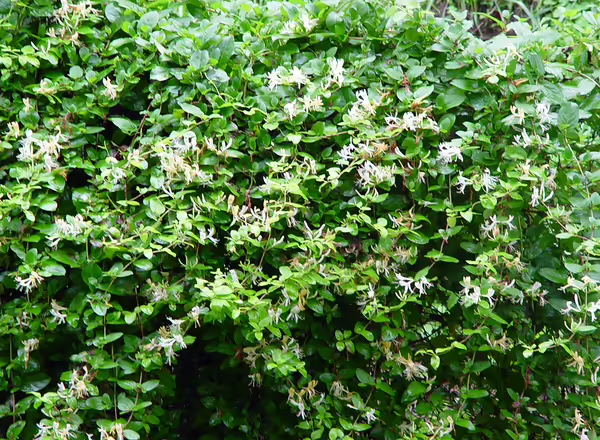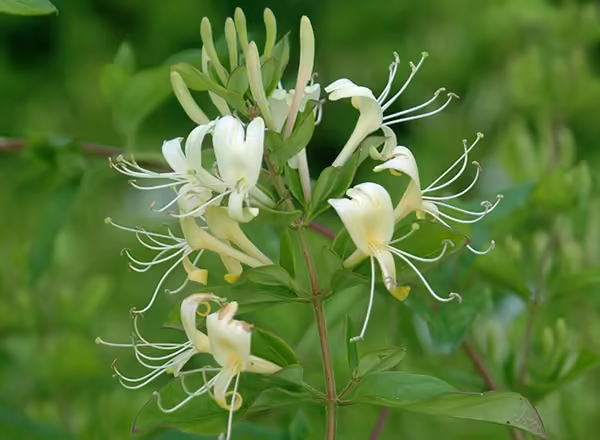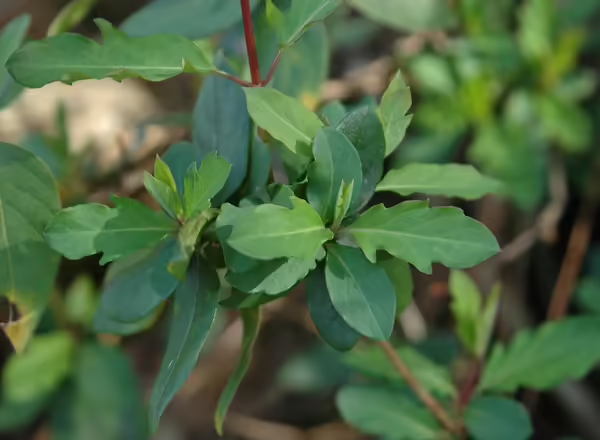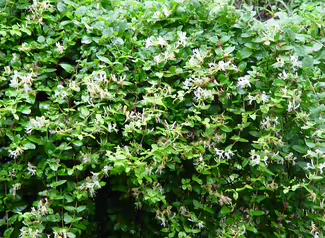
Invasive Japanese Honeysuckle
Japanese honeysuckle (Lonicera japonica) can outcompete native vegetation in various plant communities including but not limited to prairies, barrens, glades, savannas, and bottomland and upland forests. It can send out lengthy runners, creating a dense mat which can completely cover woody species, making it a serious competitor for light. It can also create competition for resources in the soil, as it has been known to send roots out up to 15 feet horizontally and 3 to 4 feet deep. In forest settings, it can prevent new tree seedlings from growing, threatening future forests, by smothering them out.

Japanese honeysuckle is native to Japan and other areas of eastern Asia. It was introduced to the U.S. in 1806 for ground cover in horticultural settings and became widely established in the eastern U.S. by the early 1900s.
Regulation of Japanese Honeysuckle
The Illinois Exotic Weed Act lists Japanese honeysuckle as an invasive plant.

Japanese honeysuckle has oppositely arranged ovate leaves which get up to 3 inches long. Leaves typically have a smooth edge or margin, but young plants can have leaves with lobed margins. Leaves are somewhat evergreen, persisting late into the winter. Younger stems are flexible, can be slightly fuzzy, and are rusty to light brown in color while older stems are more brittle and are brown to gray in color. Flowers are tubular and appear in pairs in May and June. The fruit are small black berries which persist into the winter.


- Mechanical control: Root systems may be removed by pulling or digging, but removal of the entire root system is difficult and follow up treatments may be needed.
- Fire: Prescribed fire can kill young plants and remove dense growth to facilitate easy treatment with herbicides. Vines can also act as ladder fuels for crown fires in tree canopies.
- Chemical control: Always read and follow herbicide labels before initiating treatment.
- Foliar: Apply 1.5% to 2% glyphosate v/v in water to foliage. The best time to make this application to reduce non-target damage of native plants is during the fall after the first frost, when native plants have lost their leaves and Japanese honeysuckle is still green and healthy. Apply on a warm day when temperatures are close to or above 60°F. Alternatively, 2% triclopyr can be applied to foliage in summer through late fall.
- Basal bark/cut stump: The thick stems of large woody vines can be treated in the same way as other woody species, with 20% to 25% glyphosate (cut stump) or 10 to 20% triclopyr (cut stump or basal bark).
For more information, explore Management of Invasive Plants and Pests of Illinois.
Presented by Ryan Pankau, Extension Educator, Horticulture Illinois forests are unique plant communities of towering trees as well as tiny, spring wildflowers. Invasive plants threaten native plant diversity in forest communities across Illinois by out-competing our natives for water, light, and...
Invasive plants have variable responses to fire depending on species, phenology at time of fire, fire intensities, residence time, and other factors. This presentation by Extension Forestry Research Technician Kevin Rohling reviews invasive plant responses to fire and how managers and landowners...



